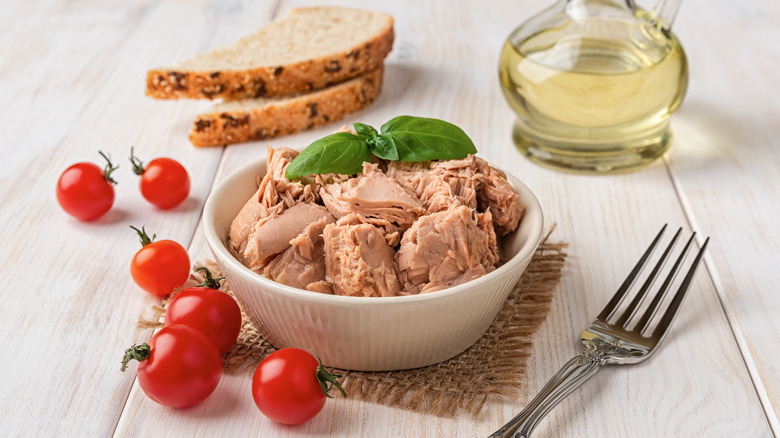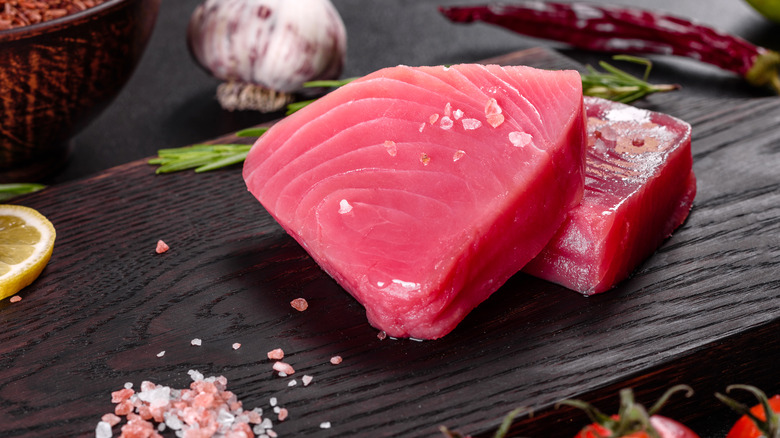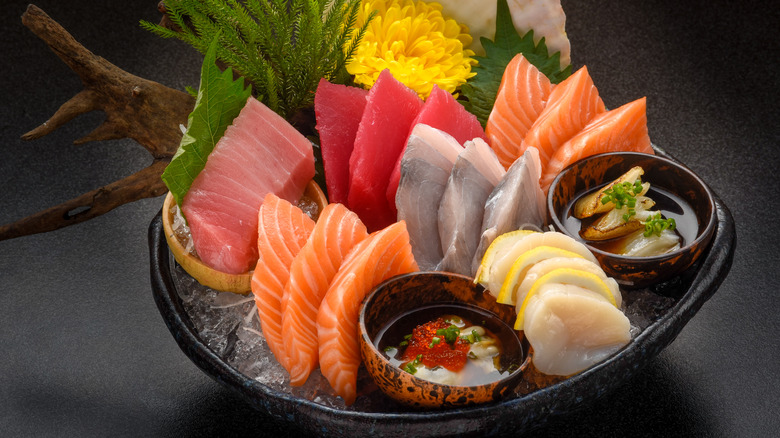When You Eat Tuna Every Day, This Is What Happens
Tuna is an affordable seafood option that can be used in everything from sushi to casseroles to sandwiches. This fish is high in protein and low in fat, making it an appealing option to people on certain diets. But it also comes with some controversy. The biggest concern about tuna is the risk of mercury poisoning. All seafood contains trace amounts of mercury, which is found in seawater and gets absorbed by ocean life (via Vice).
When too much of this metal is consumed, it can cause poisoning and various health issues. Because tuna are large fish, they tend to absorb a lot of mercury before they are caught and sold to consumers. But according to Vice, you would need to eat a lot of canned tuna to experience toxic levels of mercury. "Tinned tuna is a very low source of mercury, so people would have to be eating at least three cans a day for about six months before it really became a concern," Melanie McGrice, an accredited practicing dietitian, said. "Even pregnant women, who are one of the cohorts most at risk of mercury toxicity, can eat a small, 95-gram can on a daily basis throughout their pregnancy without concern of mercury toxicity."
You should be able to eat small amounts of canned tuna every day without issue, but Medical News Today recommends waiting three to seven days between eating tuna based on your body weight.
What to know about mercury poisoning
While your risk of mercury poisoning is lowest when eating canned tuna, it is still safe to consume moderate amounts of other types of this fish as long as you are aware of the risks and signs of mercury poisoning. According to Healthline, small amounts of mercury are found in many foods. Small traces shouldn't cause any issues for the average person. However, consuming large amounts of mercury can cause serious health issues. Mercury poisoning results in neurological effects like irritability, memory issues, anxiety, and depression. Other symptoms of this condition include lack of coordination, muscle weakness, vision changes, and hearing and speech problems.
Children and pregnant women need to be particularly careful about their intake of foods that contain mercury, including tuna. According to the FDA, pregnant women should eat no more than 12 ounces of canned tuna per week or no more than four ounces of albacore or white tuna per week. Depending on their age, children should eat between two and eight ounces of canned tuna per week and avoid other types of this fish.
Some types of tuna are better than others
There are many different kinds of tuna. The size of the fish when it is typically caught and the environment it lives in both affect how healthy the fish is (via The Healthy). Yellowfin tuna, for example, should be avoided as much as possible. A 2017 study found that yellowfin tuna can carry up to 36 times more pollutants than other kinds of this fish. These pollutants include things like flame retardants, pesticides, and polychlorinated biphenyls (PCBs), which can cause a variety of health issues when consumed too often. Albacore and skipjack tuna are two good alternatives that have a similar flavor and texture but do not contain as many pollutants.
The FDA also lists bigeye tuna as a type of fish to avoid due to high levels of mercury. According to WebMD, bluefin tuna is also high in mercury, as well as other types of fish including swordfish, imported marlin, shark, tilefish, and king mackerel. If you're concerned about how much mercury is in the fish you're eating, speak with your healthcare provider. They can help you determine which types of fish to eat and how much to eat depending on your age and health concerns.
Is raw tuna safe to eat?
Raw fish is eaten around the world thanks to popular dishes like sushi, poke, and tartare. Raw tuna is a particularly popular type of raw fish because of its firm texture and mild flavor. While many people enjoy raw tuna, you may be wondering if it's safe to eat. According to Healthline, there are several health benefits of eating this type of fish. While frying and grilling fish can expose the meat to contaminants called heterocyclic amines, raw fish is not exposed to them. Heterocyclic amines can increase your risk of developing cancer. Cooking fish also reduces the amount of omega-3 fatty acids in fish.
However, raw fish does come with some risks. Cooking fish kills bacteria and parasites that may be present in the meat. This bacteria can cause food poisoning and other health issues when eaten. While you shouldn't have an issue with fresh fish that is well-prepared, eating raw fish always comes with a risk of consuming bacteria. Raw fish also has a higher likelihood of containing mercury. You can reduce your risk of consuming bacteria when eating raw fish by only buying fish from well-reviewed restaurants and grocery stores (via Cleveland Clinic). According to the US Food and Drug Administration, you should also avoid buying frozen fish with ice crystals on the packaging. This often means that the product has been thawed and refrozen, which means it is more likely to contain harmful bacteria.
The health benefits of tuna outweigh the risks
Because your risk of mercury poisoning is relatively low, you shouldn't avoid this food if you like eating it. Tuna is packed with health benefits and is a great option to add to your diet. According to Eat This, Not That!, tuna is high in lean protein, which will help you feel fuller after eating and eat fewer calories in the long run. Tuna contains important omega-3 fatty acids that assist with brain and eye function.
According to WebMD, tuna is high in vitamin B12, which helps with the formation of red blood cells and can prevent anemia. It is also a good source of iron, vitamin B6, potassium, selenium, and iodine. Avoid canned tuna that contains added oil or salt, which are common preservatives. These can add calories to your tuna dish and cause bloating and weight gain. Stick to tuna that is canned in water. You can add tuna to salads or sandwiches as a decent protein boost. You can also use canned tuna to make a tuna burger for a leaner option than beef.





